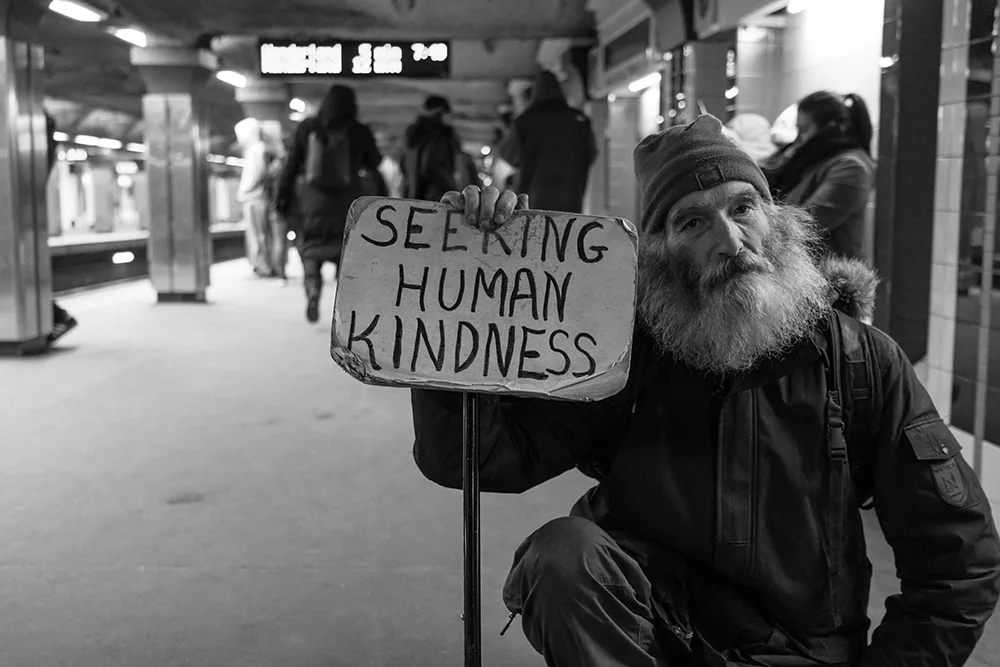What’s the experience you remember the most from your time in the working world? Does it bring up memories of joy — or of stress? As a connector of the nonprofit and business communities for over 11 years, I have to be honest: many of the memories that stick with me are moments of stress, even in the nonprofit world. What keeps me where I am are the people, the mission, and my passion for what I do.
That’s why I’ve spent the past few years focusing on how kindness is key, how it is not only the “nice thing to do,” but it’s also the “smart thing to do.” To be clear, kindness is not just hugs and smiles; it’s also pushing back on an idea that you don’t agree with, speaking up when you think voices are not being heard, and saying no to ideas that are outside of your organization’s mission.
What I’m also going to say is that my experience is of a white, cisgendered woman — and that my experience is one of privilege. I’ve made many mistakes along the way, and that’s why I’m interested in writing this and sharing it publicly. We must be kinder to each other. Recently, the Business Roundtable announced that the top CEOs around the country stated that shareholder values are no longer everything a company should be focused on. That means that we must be better managers and build better relationships with the people we spend the most amount of time with.
Over my years working in nonprofits, with our business community, and in countless interviews, meetings, and conversations, I’ve learned that, in order to create strategic, long-lasting impact and positive change for the greatest amount of people, you need four things:
- recognition of root causes of why our current system is the way it is.
- a strong, inclusive, and kind two-way feedback system between all stakeholders of your community.
- the ability to know, and admit, when you’re wrong — and then do something about it. Make the change and innovate along the way.
- collaboration and strong relationships across public, private, and nonprofit partners.
And: we should all have fun doing it!
To help provide the business perspective, I’ve asked Liz Caselli-Mechael. Not only is she on the board of the nonprofit I work for, Miriam’s Kitchen, but she is also the Digital Communications Lead for Nestlé U.S. We’ve worked together to build up a relationship between our organizations, and we have discovered many similarities in how we approach our work — from the hyper-local level at Miriam’s Kitchen to the global, macro-level at Nestlé. And we agree that kindness is key.
1. Recognize the root causes of why our current system is the way it is.
Let’s state what we know: we are built on a capitalist society, and within that, there are pros and cons. Over time, we ebb and flow from the two polar opposites of socialism and capitalism. We also know that racism is a major issue in our society and is linked to capitalism. If we can all agree on this fact, then we can also move towards a shared vision of the future. How can our businesses move to be more inclusive? More equitable?
First, we must recognize these root causes.
As Liz and I were talking, we started sharing practices on inclusion, and realized it also starts at home. Many psychological studies have found white parents are less likely than other ethnic groups to talk about race and racial inequity with their children. Without context and perspective, children come to conclusions without context. That’s one reason that children who have the ‘race talk’ at home are more respectful of other racial groups and can recognize and respond more appropriately to racism and discrimination.
From a more foundational understanding of inequality, we can start to take steps to learn how to question and then create change within our system at work. What can this mean for your organization? Talk about race. Find where you can stand out as a leader in your organization to push and say, “I don’t think this is equitable.” Or, what’s the right level of push for us right now for diversity, equity, and inclusion? At Nestlé, the role of representation is an active discussion for all content creation. That’s a fantastic start.
It starts by recognizing the root cause. A tenant of kindness: being transparent and honest.
2. Establish a strong, inclusive, and kind two-way feedback system between all stakeholders of your community.
At Nestlé Waters, the role stakeholders play in sensitive topics is really interesting. Within the past few years, they’ve radically changed their approach to siting new spring water sources. Whereas the siting process was previously considered to be potentially competitive intelligence and therefore confidential, stakeholder feedback made it clear that a confidential process wasn’t fair to community stakeholders. With the new framework, the team spells out not only the criteria for selecting sites but every step of the process, including labeling sites where they’re doing technical due diligence, exploring expansion, or even interested in potentially exploring sites for the future. No amount of trust or collaboration can start without clear transparency and opportunity for input.
Another example of building a two-way feedback system can be at the local level. At Miriam’s Kitchen we host yearly summer Listening Tours for our partners. This means we bring cookies (made fresh in our kitchen) and go to lunch or grab at least 30 minutes with partners who are invested in our work to end homelessness in DC.
And, we listen. What have we learned?
- Be open. Find out how your people and partners like to share feedback. It’s worth it.
- Set up options: a Listening Tour, survey, phone call, one-on-ones, etc.
- Building in space to share what’s working, what needs to be done, and what we need to change.
- Do you know how your partners like to receive gratitude? You should. And then send gratitude that way.
- How can you make people feel safe in the space they enter?
By building relationships with the members of your community and being able to have a two-way feedback loop, you are building trust, another core component of kindness.
3. Cultivate the ability to know, and admit, when you’re wrong — and then do something about it. Make the change and innovate along the way.
Everyone makes mistakes. When you make a mistake, instead of covering it up or making excuses, take it head on. “I didn’t do this correctly, and this is what I’m going to do about it.”
At Nestlé they believe in continuous improvement. As Liz says, they can always dive in and improve the system better and have a smarter impact.
She gave a personal example. Over the time she’s been with Nestlé, she’s helped to lead four national volunteer days. The first year was one of her first major projects with the company, and it was a free-for-all that year. The Day of Service coincided with Nestlé’s 150th birthday. Across the country the entire company signed up for 150 projects. The impact was not concentrated, and it was too much work to coordinate. The ROI was not there.
The second year, Nestlé and Liz began to align their community service work with their internal values. Sustainability was a top priority — and so many groups signed up for park clean-ups. But they found volunteers weren’t bringing as much core expertise and scale as they could.
Then into year three, Liz and the Nestlé team worked to align activities even more closely with a core area of expertise and impact in the organization: food security and hunger. The entire company paired hands-on, year-round service with large food donations and supply chain/logistics expertise, culminating in a single day but not ending there. They had a deeper impact and better understanding of the issue, and more connected partnerships. They also had tangible outputs — tens of thousands of meals prepared, as an example, creating “anchored impact.”
On August 1 of this year, they had their fourth year of their national service day. The core theme was in its second year, and Liz saw they could create more impact than ever before and continue to build relationships with the communities they worked in.
Liz and team saw major room for improvement from creating a “free-for-all” system, finding a model that would allow employees to have the most impact in their giving back. By creating guardrails for success and combining the organization on one vision for their day of service, it led to bigger outputs and a greater sense of community across the organization and within the communities where they worked side-by-side.
Two years ago, at Miriam’s Kitchen, we recognized that our business leaders who were our community ambassadors had a problem: the people who were on this council were mostly white, and mostly men. This was our group of leaders who are constantly in the community advocating for the end of homelessness in DC through their businesses. So, we were around DC, as a mostly white-led group advocating for a issue that impacted a majority of people of color. Not good. What did we do? We prioritized what leaders we asked to join our group. We talked about it at council meetings, and shared our strategy of recruiting people of color. Now, while in no ways perfect, but better, the team is comprised of 50 percent men, 50 percent women — with 40 percent people of color.
Because you have honest conversations built on trust, now you can have conversations that matter. You can speak up when you feel like you, or other key stakeholders, are not being heard. This is how kindness begins to become strategic.
4. Collaborate with and build strong relationships across public, private, and nonprofit partners.
When we all get together and rally around one cause, that’s when we can see the biggest delta in building up a community. What we know is that we cannot end homelessness alone. Other cities have — and what’s the one key indicator of success? Relationships across sectors.
The importance of relationships across sectors is critical. Businesses need nonprofits to keep them honest, and nonprofits need businesses to help fund and build awareness. Governments need business to keep the economy moving forward, and governments need nonprofits to fill the gap of social safety nets that they cannot do. We all need each other in an effort to move our society forward and to build kindness into our work.
Liz provided examples from a global level of why relationships are important across sectors: we have complementary capabilities. One of Nestlé’s biggest US partners is Feeding America. Each year, Nestlé donates hundreds of thousands of pounds of food to Feeding America. It’s a great relationship because:
- they can look at the company supply chain at any point and share their ability to donate.
- there is no way the company would be able to get food donations directly into the hands of families without the expertise of the Feeding America network.
- our strengths don’t matter unless we find complementary strengths.
- maximizing this partnership creates layers and layers of positive ripple effects, like reducing food waste.
Imagine if we paired every nonprofit with a business and government program to have them work together as complementary partners to solve an issue facing their communities. You’d have buy-in from all stakeholders, and make the community a better place to live!
This is the power of kindness in business. Being able to be yourself, bring positive change to your community, be happy, and feel empowered — no matter who you are.
We have some work to do, but I believe that if we open our doors to the recognition of root causes, a two-way feedback system, admission of when you’re wrong and doing something about it, and collaborate across sectors — we can and will make change.





